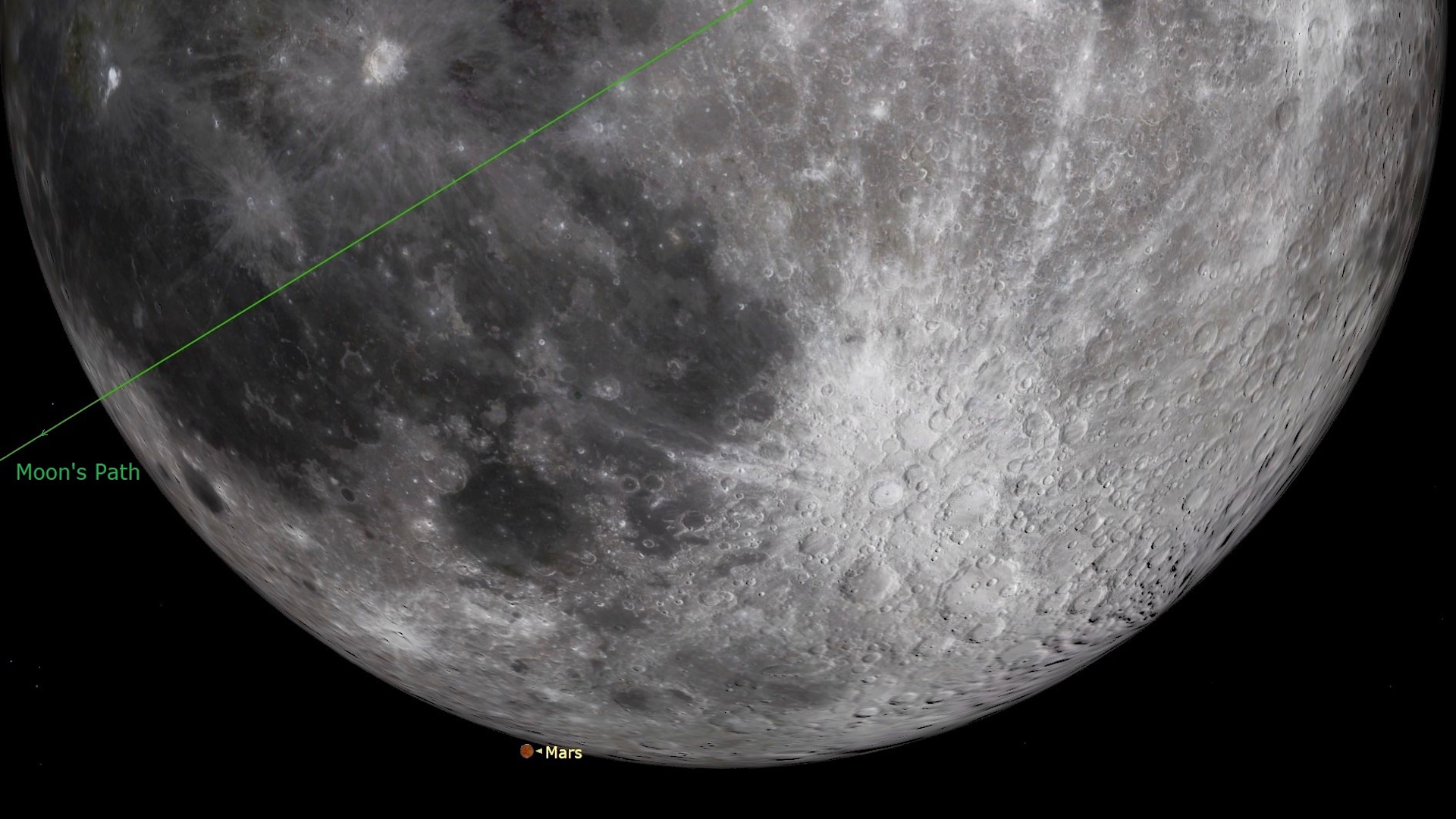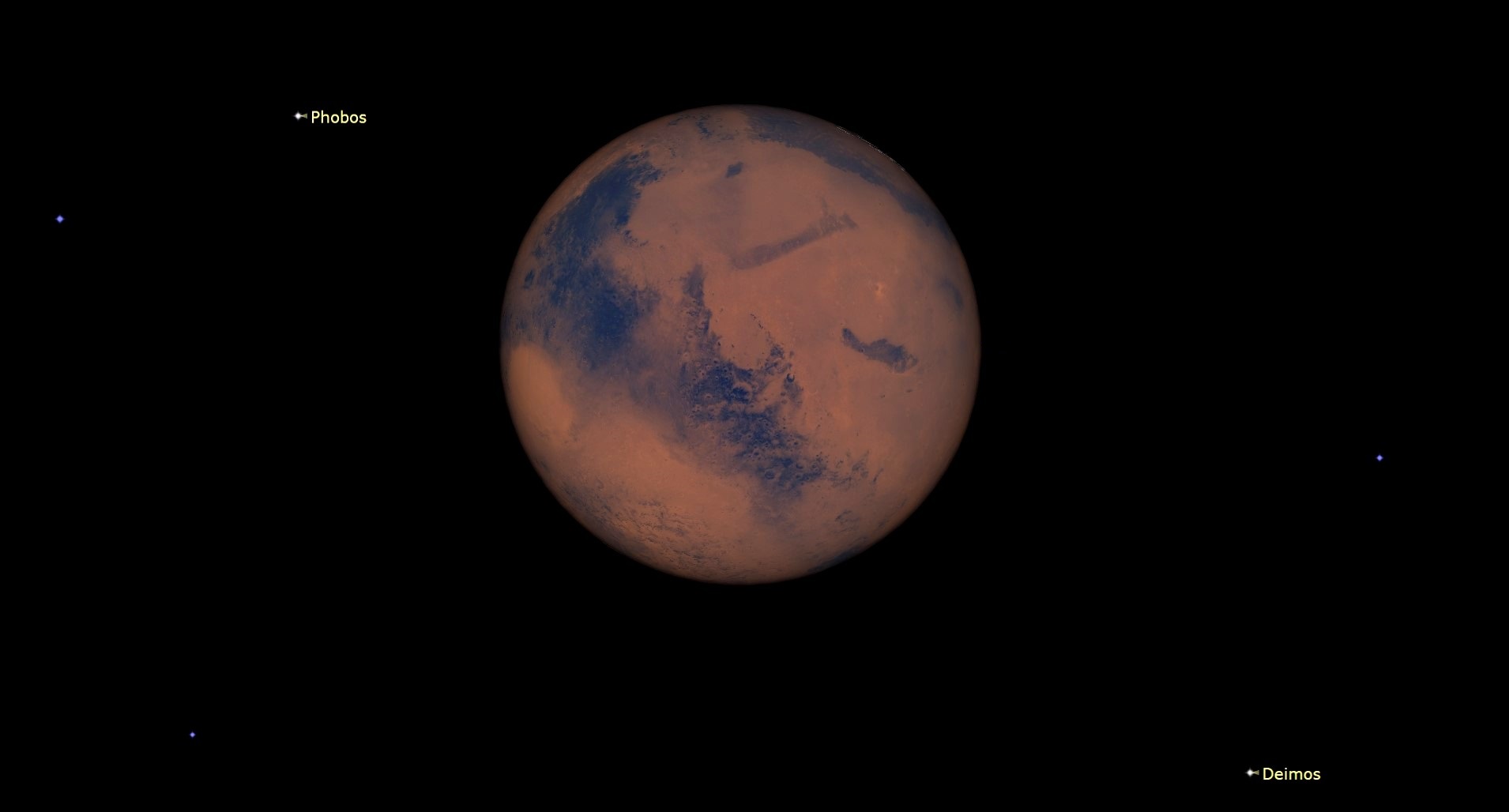Every once in a while, something will appear in the sky that will attract the attention of even those who normally don’t bother looking up.
It’s likely to be that way in the evening hours of Wednesday (Dec. 7) when the full moon will appear in very close proximity to the now-brilliant planet Mars. In fact, the moon will turn full at 11:08 p.m. EST (0408 GMT on Dec. 8) followed by Mars arriving at opposition to the sun just 87 minutes later. This will result in an almost perfect alignment in space of the sun, Earth, moon and Mars.
People, who are unaware or have no advance notice, will almost certainly wonder, as they cast a casual glance toward our nearest neighbor in space on this first Wednesday in December, just what is that “bright orange-yellow light”? Sometimes, such occasions bring with them a sudden rash of phone calls to radio and television stations, local planetariums, weather offices and police precincts. Not a few of these calls excitedly inquire about “the mysterious UFO” that’s closely hovering in the vicinity of our natural satellite!
If you don’t live in any of the locations listed below that will provide a good chance to see the event in person, you’re in luck: The Virtual Telescope Project will be hosting a livestream of Mars at opposition (opens in new tab) beginning at 11:00 p.m. EST on Dec. 7 (0400 GMT on Dec. 8).
Related: December full moon 2022: The Cold Moon occults Mars
Joe Rao is a veteran meteorologist and eclipse chaser who also serves as an instructor and guest lecturer at New York’s Hayden Planetarium.
Where to see the moon eclipse Mars
As a bonus, those who are located north and west of a line running roughly from Piedras Negras, Mexico to Louisville, Kentucky to Seabrook, New Hampshire will see the moon occult Mars. Refer to the US map. Those positioned south and east of this line, however, will see the moon miss the planet entirely, barely passing just above it (called an appulse).
But for an observer fortuitously positioned exactly on, or immediately adjacent to that line — it’s actually a narrow path about 21 miles (34 km) wide — the lower limb of the moon will appear to literally graze Mars as it passes by.
For those fortuitously situated along the northern edge of the path, the planet’s dazzling topaz disk may appear to disappear completely, then reappear intermittently in lunar valleys. In contrast, along the southern edge of the path, Mars’ northern edge will only briefly touch the limb of the moon.
Among towns and cities located within the path are Morgantown, WV; Scranton, PA; Hudson, NY; Northampton, MA; Lowell, MA and Seabrook, NH. Refer to the Mars occultation graze path maps.
Unlike a star which is a pinpoint of light and would disappear and reappear in an instant, Mars appears as a small disk in telescopes; owing to its relatively large angular size (17.2 arc seconds in diameter), the occultation will occur at a rather “leisurely” pace. So the disappearance of Mars behind the moon’s bright limb for most places, will take anywhere from about 40 seconds to almost a minute (or even longer where the moon’s limb approaches it at a slant).
From Austin, for instance, the moon’s slow eastward drift will take more than two minutes to completely cover, and later uncover the planet’s disk — and even longer for those to the south and closer in to the northern limit of the graze path, where the moon’s limb will approach at even more of a slant.
The planet’s reappearance will also be gradual. The actual term is called an occultation (Latin for “hiding”). One might even refer to this upcoming event as an eclipse of the planet Mars. Moving to the east against the background stars at its own apparent diameter each hour, the moon will appear to approach Mars from the west (right) and ultimately pass in front of it, and then shortly thereafter, uncover it, and leaving it behind as the moon continues to move to the east.

Plainly visible with just your eyes
An opportunity to see the moon occult a bright planet at night does not happen too often; for Mars for a specific location on Earth it happens (on average) once about every 14 years. So, if you are fortunate to live in the occultation zone and the weather gods cooperate, this upcoming event is one that really should not be missed.
Since Mars will be at opposition when it has its lunar rendezvous, it will be shining at its very brightest for this current apparition. Normally, even a bright star can be quite difficult to see when in such close proximity to the dazzling brilliance of a full moon. Yet, because Mars is as bright as it is (magnitude -1.9; nearly twice as bright as Sirius, the brightest star), this spectacular vanishing act can be watched with just your unaided eye or binoculars, although the very best views will certainly be afforded with a telescope.
Table 1 provides the specific details for 27 selected cities in the United States and Canada. For times with an asterisk (*), the calendar date is Dec. 8.
| Location | Time zone | Mars disappears | Mars reappears |
|---|---|---|---|
| Juneau | AKST | 6:19 p.m. | 6:55 p.m. |
| Los Angeles | PST | 6:30 p.m. | 7:30 p.m. |
| San Francisco | PST | 6:34 p.m. | 7:35 p.m. |
| Seattle | PST | 6:51 p.m. | 7:50 p.m. |
| Vancouver | PST | 6:55 p.m. | 7:52 p.m. |
| Tucson | MST | 7:32 p.m. | 8:27 p.m. |
| Las Vegas | MST | 7:34 p.m. | 8:35 p.m. |
| Salt Lake City | MST | 7:41 p.m. | 8:46 p.m. |
| Denver | MST | 7:44 p.m. | 8:48 p.m. |
| Helena | MST | 7:51 p.m. | 8:56 p.m. |
| Edmonton | MST | 8:04 p.m. | 9:06 p.m. |
| Yellowknife | MST | 8:23 p.m. | 9:16 p.m. |
| Whitehorse | MST | 8:25 p.m. | 8:57 p.m. |
| Tulsa | CST | 8:54 p.m. | 9:41 p.m. |
| Kansas City | CST | 8:56 p.m. | 9:52 p.m. |
| Austin | CST | 8:57 p.m. | 9:12 p.m. |
| Saskatoon | CST | 9:03 p.m. | 10:10 p.m. |
| Winnipeg | CST | 9:05 p.m. | 10:16 p.m. |
| Chicago | CST | 9:10 p.m. | 10:04 a.m. |
| Memphis | CST | 9:14 p.m. | 9:29 p.m. |
| Churchill | CST | 9:22 p.m. | 10:31 p.m. |
| Louisville | EST | 10:21 p.m. | 10:47 p.m. |
| Toronto | EST | 10:29 p.m. | 11:17 p.m. |
| Montreal | EST | 10:40 p.m. | 11:29 p.m. |
| Quebec City | EST | 10:45 p.m. | 11:36 p.m. |
| Halifax | AST | 12:15 a.m.* | 12:33 a.m.* |
| Gander | NST | 12:47 a.m.* | 1:37 a.m.* |
The above table gives civil times of Mars’ disappearance and reappearance from behind the moon. Both the disappearance and reappearance of the planet, can last anywhere from 40 seconds to over two minutes, depending on whether Mars passes centrally behind the moon (and is covered for an hour or more) or near its lower edge at a slant (and is covered for less than a half hour). Disappearance and reappearance times are for Mars’ center.
Table was adapted from data provided by the International Occultation Timing Association (IOTA) (opens in new tab).

Don’t miss this near miss!
For the rest of North America, this will be an exceedingly close approach of the moon to Mars (called an appulse). The moon, moving around the Earth in an easterly direction at roughly its own diameter each hour will seem to creep slowly toward and ultimately pass just above the ochre planet. Even though the heavily populated Southeast and Eastern United States will miss out on an occultation, Mars will almost command people to look at it, as it slowly appears to glide below the moon.
For places like Huntsville, Knoxville, Philadelphia and New York, Mars will come to within just 1 arc minute of the moon’s limb; they’ll almost seem to touch each other. To the naked eye, Mars will look like an amber jewel on the bottom edge of the moon. From Boston the gap between Mars and the moon’s limb is even smaller: just 0.6 arc minute, roughly equal to the apparent width of two Mars diameters!
After closest approach, the moon will move slowly away from Mars through the balance of the overnight hours of Dec. 7 and Dec. 8.
Table 2 provides the specific details for 15 selected cities in the continental U.S., Puerto Rico and Bermuda. For times with an asterisk (*), the calendar date is Dec. 8.
| Location | Time zone | Closest approach | Separation |
|---|---|---|---|
| New Orleans | EST | 9:11 p.m. | 3 arc min. |
| Huntsville | EST | 9:23 p.m. | 1 arc min. |
| Miami | EST | 10:16 p.m. | 11 arc min. |
| Jacksonville | EST | 10:23 p.m. | 7 arc min. |
| Atlanta | EST | 10:26 p.m. | 3 arc min. |
| Columbia | EST | 10:31 p.m. | 4 arc min. |
| Knoxville | EST | 10:31 p.m. | 1 arc min. |
| Charlotte | EST | 10:36 p.m. | 3 arc min. |
| Norfolk | EST | 10:46 p.m. | 4 arc min. |
| Washington | EST | 10:46 p.m. | 2 arc min. |
| Philadelphia | EST | 10:51 p.m. | 1 arc min. |
| New York | EST | 10:56 p.m. | 1 arc min. |
| Boston | EST | 11:01 p.m. | 0.6 arc min. |
| San Juan | AST | 11:51 p.m. | 23 arc min. |
| Hamilton | AST | 12:06 a.m.* | 11 arc min. |
The above table gives civil times (all a.m.) of Mars’s closest approach to the edge of the moon’s lower limb. Separation between Mars and the moon’s lower edge is given in terms of minutes of arc (the apparent width of the moon on Dec. 7 is 30 arc minutes).
Example: From Jacksonville, closest approach is 10:23 p.m. EST, the separation is listed at 7 arc minutes or fractionally roughly 1/4 of the moon’s width will separate Mars from the moon’s lower edge.
Europe too! And after 2022, your next opportunity
Europeans will also be able to partake in this occultation, although for them this event will occur during the predawn morning hours of Thursday (Dec. 8) with the moon descending the west-northwest sky. For Lisbon, Mars will disappear behind the moon at 4:28 a.m. local time and will reappear at 5:02 a.m. For Dublin it’s 4:55 a.m. and 5:56 a.m. London: 5:00 a.m. and 5:59 a.m. Berlin: 6:01 a.m. and 6:56 a.m. Paris: 6:04 a.m. and 7:02 a.m., and Madrid 6:21 a.m. and 7:07 a.m.
The next favorable occultation of Mars for North America will take place on January 14, 2025. at around 4h UT. The moon will be a waning gibbous about 6 hours past full. Mars comes to opposition just two days later.
Joe Rao serves as an instructor and guest lecturer at New York’s Hayden Planetarium (opens in new tab). He writes about astronomy for Natural History magazine (opens in new tab), the Farmers’ Almanac (opens in new tab) and other publications. Follow us on Twitter @Spacedotcom (opens in new tab) and on Facebook (opens in new tab).

